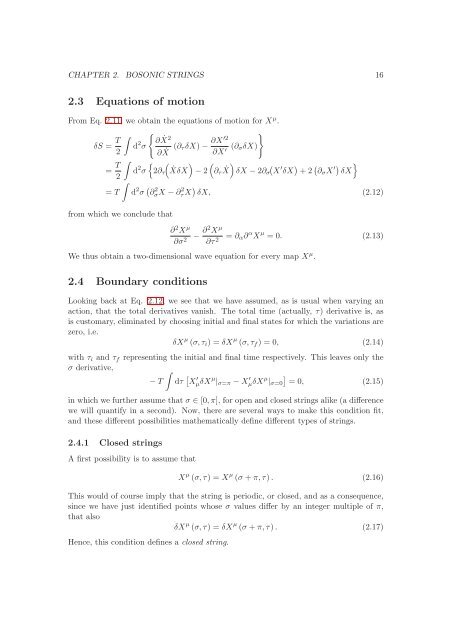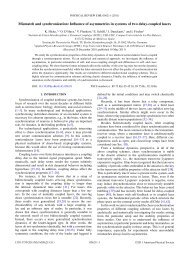DBI Analysis of Open String Bound States on Non-compact D-branes
DBI Analysis of Open String Bound States on Non-compact D-branes
DBI Analysis of Open String Bound States on Non-compact D-branes
You also want an ePaper? Increase the reach of your titles
YUMPU automatically turns print PDFs into web optimized ePapers that Google loves.
CHAPTER 2. BOSONIC STRINGS 162.3 Equati<strong>on</strong>s <str<strong>on</strong>g>of</str<strong>on</strong>g> moti<strong>on</strong>From Eq. 2.11, we obtain the equati<strong>on</strong>s <str<strong>on</strong>g>of</str<strong>on</strong>g> moti<strong>on</strong> for X µ .δS = T ∫ {}d 2 σ∂Ẋ22 ∂Ẋ (∂ τδX) − ∂X′2∂X ′ (∂ σ δX)= T ∫) ( )d 2 (σ{2∂ τ(ẊδX − 2 ∂ τ Ẋ δX − 2∂ σ X ′ δX ) + 2 ( ∂ σ X ′) }δX2∫= T d 2 σ ( ∂σX 2 − ∂τX 2 ) δX, (2.12)from which we c<strong>on</strong>clude that∂ 2 X µ∂σ 2 − ∂2 X µ∂τ 2 = ∂ α ∂ α X µ = 0. (2.13)We thus obtain a two-dimensi<strong>on</strong>al wave equati<strong>on</strong> for every map X µ .2.4 <str<strong>on</strong>g>Bound</str<strong>on</strong>g>ary c<strong>on</strong>diti<strong>on</strong>sLooking back at Eq. 2.12, we see that we have assumed, as is usual when varying anacti<strong>on</strong>, that the total derivatives vanish. The total time (actually, τ) derivative is, asis customary, eliminated by choosing initial and final states for which the variati<strong>on</strong>s arezero, i.e.δX µ (σ, τ i ) = δX µ (σ, τ f ) = 0, (2.14)with τ i and τ f representing the initial and final time respectively. This leaves <strong>on</strong>ly theσ derivative, ∫− T dτ [ X µδX ′ µ | σ=π − X µδX ′ µ ]| σ=0 = 0, (2.15)in which we further assume that σ ∈ [0, π], for open and closed strings alike (a differencewe will quantify in a sec<strong>on</strong>d). Now, there are several ways to make this c<strong>on</strong>diti<strong>on</strong> fit,and these different possibilities mathematically define different types <str<strong>on</strong>g>of</str<strong>on</strong>g> strings.2.4.1 Closed stringsA first possibility is to assume thatX µ (σ, τ) = X µ (σ + π, τ) . (2.16)This would <str<strong>on</strong>g>of</str<strong>on</strong>g> course imply that the string is periodic, or closed, and as a c<strong>on</strong>sequence,since we have just identified points whose σ values differ by an integer multiple <str<strong>on</strong>g>of</str<strong>on</strong>g> π,that alsoδX µ (σ, τ) = δX µ (σ + π, τ). (2.17)Hence, this c<strong>on</strong>diti<strong>on</strong> defines a closed string.
















